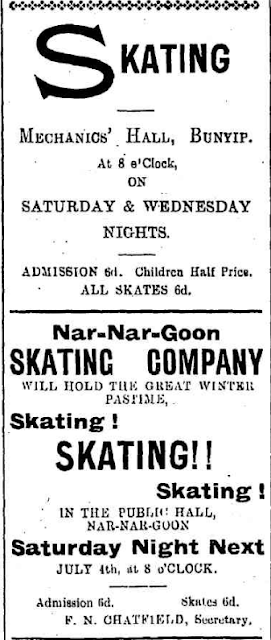This appeared in The Argus, on November 26, 1912, 100 years ago this week. It has both a Railway connection (one of my historical interests) and a Swamp connection as Dalmore and Koo-Wee-Rup were Swamp Stations and Tooradin, Monomeith and Caldermeade were on the edge of the Swamp.
\
This line is part of the Great Southern line - the line to Dandenong (part of the Oakleigh to Bunyip section) opened October 8, 1877. Dandenong to Tooradin, with stations at Lyndhurst, Cranbourne, Clyde and Tooradin opened October 1, 1888. Dalmore (originally called Peer’s Lane, then Koo-Wee-Rup West) and Koo-Wee-Rup (originally called Yallock) opened August 19, 1889. Monomeith (originally called Glassock’s), Caldermeade, and Lang Lang (originally called Carrington) opened in February 1890. The line went all the way to Port Albert by 1892.
Patsy Adam-Smith wrote about the Monomeith Railway Station in her book
Hear the train blow. Her mother was station mistress and post mistress and her father was a fettler. She wrote that
Monomeith had no pub, no shop nothing but us. The Railway Station was also the Post Office. The family lived on a house on the platform and Patsy went to Monomeith School until it closed in 1933 and she then travelled by train to Caldermeade School. The family were at Monomeith during the 1934 flood. This is (partly) what Patsy wrote about the flood -
At home we were perfectly safe because of the house being
off the ground up on the platform. On the second day Mum heard on the radio
that homeless people were being brought into the Railway station at Koo-Wee-Rup. She walked in to help. Where she walked on
the five-foot the swirling waters lapped over her shoes, the ballast had been
swept away and the sleepers were held up only because they were fastened to the
rails. The whole line in parts was swinging…..Dad and other fettlers brought in
scores of people who had been cut off on high ground or in the ceilings of their
homes. The water had run over the land so suddenly that most people were taken
unawares. The Bush Nursing Hospital was caught this way. The fettlers cut
through the roof of that building to take out the patients…… Mum, helping
patients out of the boat when it reached Koo-Wee-Rup station found Dad’s coat
around an old lady who had only a thin nightdress beneath it.
Sadly, none of the Monomeith railway buildings remain. According to a report in a Korumburra & District Historical Society newsletter, that we received a few months ago at the Koo-Wee-Rup Swamp Historical Society, passenger services beyond Dandenong ceased in June 1981 but goods services continued to operate. In 1992, the goods trains ceased and this is when the line beyond Leongatha was taken up. The passenger service to Leongatha was reinstated on December 9 1984 and continued to run until July 23 1993. The trains now stop at Cranbourne.




























.jpg)
